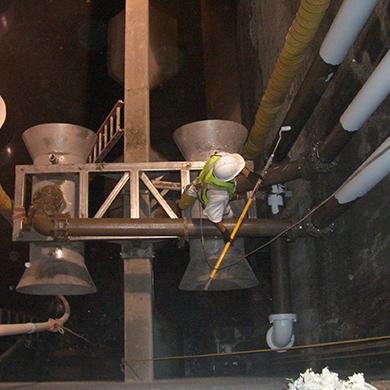Exhaust Stacks and Vents: Critical Components of an Odor Control System
Once odorous emissions from wastewater and collections systems are contained, and if possible, controlled, they are generally released into the atmosphere, often through a stack or vent. Careful design of these exhaust stacks is a critical, but often oversimplified last step in the odor control process. Ineffectively designed, the exhaust of emissions from the various wastewater processes can result in high odor impacts downwind of a stack, leading to odor complaints and potential enforcement actions, or even civil suits. This last component of an odor control system, the exhaust stack, is discussed in detail in this paper.
The various factors that affect the dispersion of the odors from the stack include:
- Strength and character of the odors
- Dimensions and exhaust parameters of the stack (e.g., stack height, stack diameter, exhaust velocity, and temperature)
- Exhaust stack location relative to nearby structures
- Local meteorology (e.g., wind speed and direction, atmospheric stability)
- Nearby terrain features (e.g., hills, valleys)
- Proximity to sensitive receptors, such as residential areas, schools, parks, etc.
When designed and constructed with consideration of these factors, the likelihood of offsite odor impacts can be significantly reduced or eliminated. And at those times when the odor control system is not operating at optimal performance, a well-designed odor control exhaust stack can also provide that extra level of insurance needed to prevent nuisance odors within the community.
The paper will present the influence that these various features have on how odors are dispersed from a stack or vent, and on what factors to consider when designing an odor control stack in order to effectively disperse the odors without negatively impacting the surrounding communities (as well as onsite staff). Real world examples of stack designs that resulted in high ground level odor impacts will be presented, including:
- Short stacks
- The use of a rain cap
- Gooseneck, or horizontal exhaust stacks
While the initial rationale for the installation of these typical types of exhaust stacks seemed reasonable at the time, their use resulted in a significant reduction in the dispersion of the odors with a corresponding increase in offsite odors. The paper will discuss the important principles to consider when designing an exhaust stack for odor control in order to prevent high odor impacts, including a discussion of some of the newer exhaust stacks designed to enhance the dispersion of odors, including high dilution, and mixed flow fans.
The paper will discuss how to evaluate the effectiveness of a proposed design, including the use of odor dispersion modeling, and provide examples of how modeling is currently used both for design and regulatory purposes to demonstrate the effectiveness of odor control stacks.






